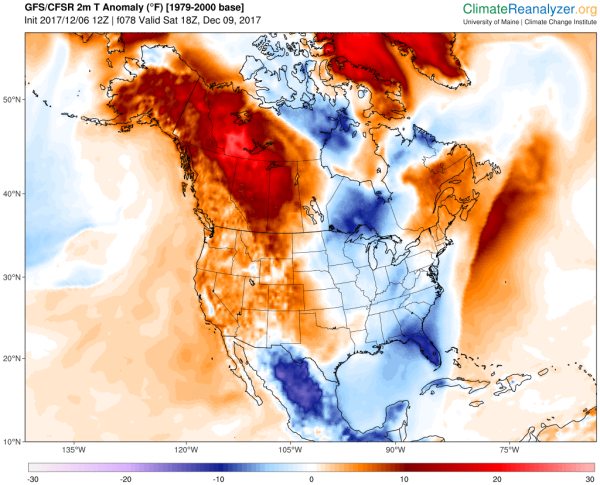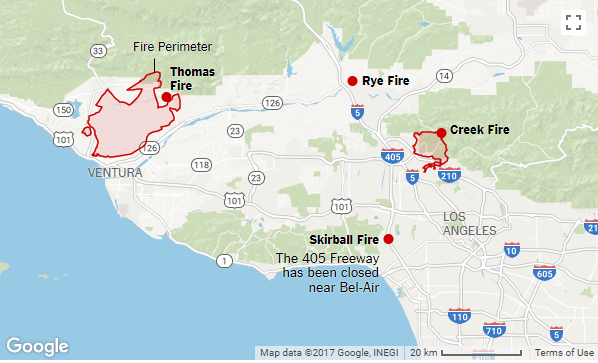Winter is Supposedly Coming; So Why is California Burning?
6
December, 2017
As
forecasters expect a warming climate will make Santa Ana winds more
frequent and faster, that Santa Ana blowtorch is likely to do a lot
more damage to the developed parts of the state. — One
of the conclusions of a recent climate study.
*****
The
popular refrain these days is that ‘winter is coming.’ But for
California and the North American West, this is clearly not the case.
(Four
large wildfires burn across Los Angeles in this December 5 satellite
shot. Image source: NASA
Worldview.)
Conditions
across the West have been drier lately. Hotter lately. A lot less
winter-like during the winter season lately. Add in the fact that
climate change is expected
to increase the strength of the wildfire-sparking Santa Ana winds and
this trend of ebbing winter is a rather serious factor.
The
very reason why we use the words — fire season — is due to the
fact that fire is more prevalent when it is hotter, when it is drier,
and when the dry winds blow more strongly. For California, fire
season happens twice a year — once in early summer and again in
autumn as the dry Santa Ana winds begin to howl.
(Consistent
unseasonal heat and the development of powerful high pressure ridges
over the North American West amplify the Santa Ana winds and set the
stage for more severe wildfires. This week, a strong ridge and
related abnormal warmth and drought helped to fan a historic Los
Angeles outbreak. Image source: Climate
Reanalyzer.)
The
Santa Ana season lasts from October through April. It notable due to
the fact that it tends to threaten more heavily populated areas. Its
primary mitigating factor — cooler winter weather — is receding.
And, according
to this research,
the same factors that are warming the U.S. West are also making the
Santa Ana winds blow stronger. So
we have good reason to believe that the effects of human-caused
climate change are making California’s fall and winter fire season
considerably worse.
Today
is December 6, just a little more than two weeks before the Winter
Solstice. Seasonally, we are at the gates of winter. Winter should be
coming. But, instead, we have drought in Southern California. Instead
we have had consistently warmer than normal weather over the past 30
days. Instead
we have 70 mile per hour Santa Ana winds raging over
withering peaks and through the drying valleys. These are conditions
consistent with a fire season amplified by climate change. Not with
normal winter.
And
today, in Los Angeles alone, we have four fires raging
simultaneously.
The
largest fire, the Ventura Fire, has
now burned more than 65,000 acres.
It threatens 12,000 buildings. And it is already estimated to
have consumed
at least 150 of these structures.
The fire has cut off power to upwards of 250,000 people and has
forced numerous closures and evacuations.
The
Creek Fire, Rye Fire, and Skirball Fire have reportedly burned
an additional 15,000 acres and forced more than 150,000 people to
evacuate.
The Skirball fire is threatening
the Getty Museum even
as it has forced the closure of a section of highway 405. This
150 acre fire is also encroaching upon a 28 million dollar home owned
by right wing media mogul — Rupert Murdoch. Notably, Rupert has
used his media empire to support the views of climate change deniers
and has
called rational concern over climate change related risks
‘nonsense.’Today,
one of his many homes may burn as a result of such ‘nonsense.’
In
total, more than 1,000 firefighters are presently battling these four
fires around the Los Angeles region. And the risks to the city are
now as high as they have ever been. For on Wednesday, weather
forecasters are calling for Santa Ana winds to continue to gust as
high as 70 miles per hour. With the strength of these powerful
fire-inducing winds peaking on Thursday as
gusts are predicted to hit as high as 80 miles per hour.
The winds will loft sparks and burning material from the fires and
drop it over the city — creating nightmare conditions for
firefighters trying to contain the four blazes. Red flag warnings —
indicating that conditions are ideal for fire combustion — are
expected to remain in place over Southern California through Friday.






No comments:
Post a Comment
Note: only a member of this blog may post a comment.